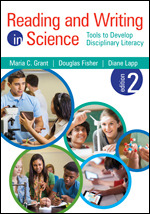Reading and Writing in Science
Tools to Develop Disciplinary Literacy
- Maria C. Grant - California State University, Fullerton, USA
- Douglas Fisher - San Diego State University, USA
- Diane Lapp - San Diego State University, USA
Engage your students in scientific thinking across disciplines!
Did you know that scientists spend more than half of their time reading and writing? Students who are science literate can analyze, present, and defend data – both orally and in writing.
The updated edition of this bestseller offers strategies to link the new science standards with literacy expectations and specific ideas you can put to work right away. Features include:
- A discussion of how to use science to develop essential 21st century skills
- Instructional routines that help students become better writers
- Useful strategies for using complex scientific texts in the classroom
- Tools to monitor student progress through formative assessment
When students are curious, they thrive. Give your students the strong base they need to create and share scientific ideas that have an impact in the classroom and beyond.
“This is a teacher-friendly book that drew me in from the introduction to the end. Through real-life scenarios combined with useful methods for instruction, it illustrates how science teachers can use language as a tool for teaching science.”
-Trina Allen, Science Content Specialist
Measurement Incorporated
“An eminently readable guide for the novice and experienced teacher. The many practical ideas in this volume demonstrate that improving students’ skills in reading and writing can also improve their understanding and ability in science.”
- Cary Sneider, Associate Research Professor
Portland State University, Portland, OR
“The authors of Reading and Writing in Science bring together expertise in Next Generation Science Standards, English language arts, and excellent teaching methods to produce an eminently readable guide for the novice and experienced teacher.
Teachers who wish to teach science while improving their students’ reading and writing skills will find a wealth of practical ideas in this volume.
The many practical ideas in this volume demonstrate that improving students’ skills in reading and writing can also improve their understanding and abilities in science.”
"Reading and Writing in Science is a teacher friendly book that drew me in from the introduction to the end. Through real life scenarios combined with useful methods for instruction, it illustrates how science teachers can use language as a tool for teaching science."
The real strength of the book is the almost equal weighting given to the four strands of literacy; oral, aural, reading and writing. This provides a useful prompt for the reader to go beyond the obvious when incorporating a greater literacy focus into their curriculum.
